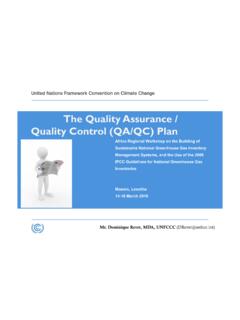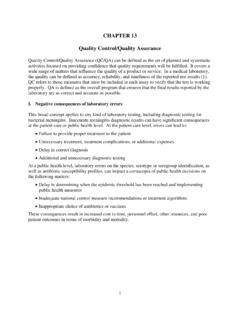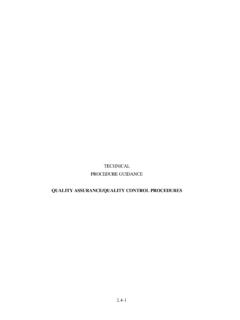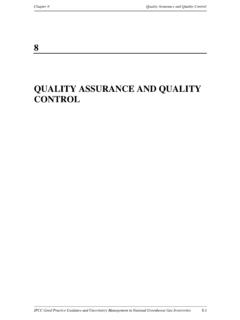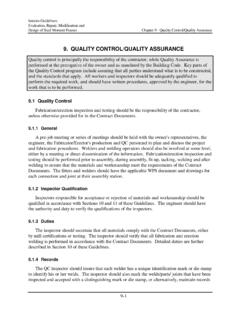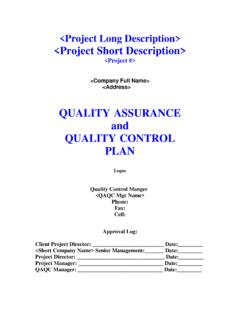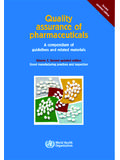Transcription of 5. QUALITY ASSURANCE AND QUALITY CONTROL
1 5. QUALITY ASSURANCE AND QUALITY CONTROL INTRODUCTION QUALITY ASSURANCE (QA) and QUALITY CONTROL (QC) are commonly thought of as procedures used in the laboratory to ensure that all analytical measurements made are accurate. Yet QA and QC extend beyond the laboratory and are essential components of all phases and all activities within each phase of a nonpoint source (NPS) monitoring project. This section defines QA and QC, discusses their value in NPS monitoring programs, and explains EPA s policy on these topics.
2 The following sections provide detailed information and recent references for planning and ensuring QUALITY data and deliverables that can be used to support specific decisions involving nonpoint source pollution. Definitions of QUALITY ASSURANCE and QUALITY CONTROL QUALITY ASSURANCE : An integrated system of management procedures and activities used to verify that the QUALITY CONTROL system is operating within acceptable limits and to evaluate the QUALITY of data (Taylor, 1993; USEPA, 1994c). QUALITY CONTROL : A system of technical procedures and activities developed and implemented to produce measurements of requisite QUALITY (Taylor, 1993; USEPA, 1994c).
3 QC procedures include the collection and analysis of blank, duplicate, and spiked samples and standard reference materials to ensure the integrity of analyses and regular inspection of equipment to ensure it is operating properly. QA activities are more managerial in nature and include assignment of roles and responsibilities to project staff, staff training, development of data QUALITY objectives, data validation, and laboratory audits. Table 5-1 lists some common activities that fall under the headings of QA and QC.
4 Such procedures and activities are planned and executed by diverse organizations through carefully designed QUALITY management programs that reflect the importance of the work and the degree of confidence needed in the QUALITY of the results. Importance of QA/QC Programs Although the value of a QA/QC program might seem questionable while a project is under way, its value should be quite clear after a project is completed. If the objectives of the project were used to design an appropriate data collection and analysis plan, all QA/QC procedures were followed for all project activities, and accurate and complete records were kept throughout the project, the data and information collected from the project will be adequate to support a choice from among alternative courses of action.
5 In addition, the course of action chosen will be defensible based on the data and information collected. Development and implementation of a QA/QC program can require up to 10 to 20 percent of project resources (Cross-Smiecinski and Stetzenback, 1994), but this cost can be recaptured in lower overall costs due to the project s being well planned and executed. Likely problems are anticipated and accounted for before they arise, eliminating the need to spend countless hours and dollars resampling, reanalyzing data, or mentally reconstructing portions of the project to determine where an error was introduced.
6 QA/QC procedures and activities are cost-effective measures used to determine how to allocate project energies and resources toward improving the QUALITY of research and the usefulness of project results (Erickson et al., 1991). 5-1 QA/QC Chapter 5 5-2 Table 5-1. Common QA and QC activities. QA Activities Organization of project into component parts Assignment of roles and responsibilities to project staff Use of statistics to determine the number of samples and sampling sites needed to obtain data of a required confidence level Tracking of sample custody from field collection through final analysis Development and use of data QUALITY objectives to guide data collection efforts Audits of field and laboratory operations Maintenance of accurate and complete records of all project
7 Activities Personnel training to ensure consistency of sample collection techniques and equipment use QC Activities Collection of duplicate samples for analysis Analysis of blank and spike samples Replicate sample analysis Regular inspection and calibration of analytical equipment Regular inspection of reagents and water for contamination Regular inspection of refrigerators, ovens, etc. for proper operation Adapted from Drouse et al., 1986, and Erickson et al., 1991. This chapter discusses many elements and aspects of QA/QC programs that do not differ significantly from one type of program to another for instance, from a point source permit compliance sampling program to an NPS best management practice effectiveness monitoring program.
8 Therefore, much of the following discussion is not specific to NPS projects. This does not, however, mean that a well-designed and well-implemented QA/QC program is not necessary for an NPS project. It is hoped that the following discussion will convey to the reader the importance of QA and QC to the success of every project involving the collection and analysis of environmental data. EPA QUALITY Policy EPA has established a QA/QC program to ensure that data used in research and monitoring projects are of known and documented QUALITY to satisfy project objectives.
9 The use of different methodologies, lack of data comparability, unknown data QUALITY , and poor coordination of sampling and analysis efforts can delay the progress of a project or render the data and information collected from it insufficient for decision making. QA/QC practices should be used as an integral part of the development, design, and implementation of an NPS monitoring project to minimize or eliminate these problems (Erikson et al., 1991; Pritt and Raese, 1992; USEPA, 1994d). Chapter 5 QA/QC EPA s mandatory agency-wide QUALITY System policy requires each office or laboratory generating data to implement minimum procedures to ensure that precision, accuracy, completeness, comparability, and representativeness of data are known and documented (Erickson et al.)
10 , 1991; USEPA, 1984c ). This policy is now based on the QUALITY system standard developed by the American Society of QUALITY CONTROL (ASQC, 1994). Each office or laboratory is required to specify the QUALITY levels that data must meet to be acceptable and satisfy project objectives. This requirement applies to all environmental monitoring and measurement efforts mandated or supported by EPA through regulations, grants, contracts, or other formal agreements. To ensure that this responsibility is met uniformly across EPA, each organization performing work for EPA must document in a QUALITY Management Plan (QMP) that is approved by its senior management how it will plan, implement, and assess the effectiveness of QA and QC operations applied to environmental programs (USEPA, 1994d).










